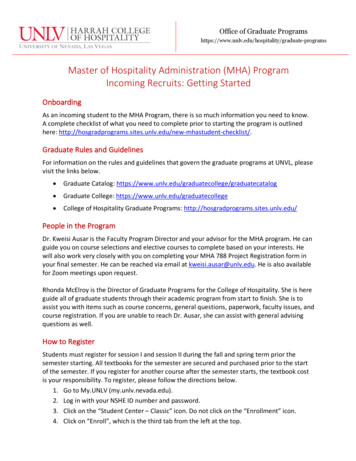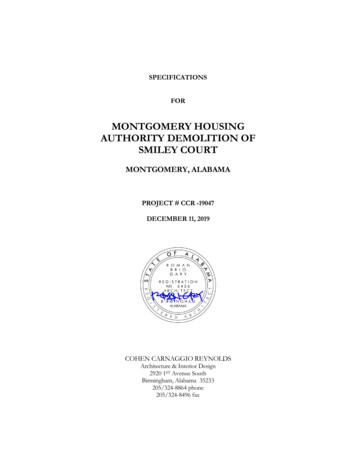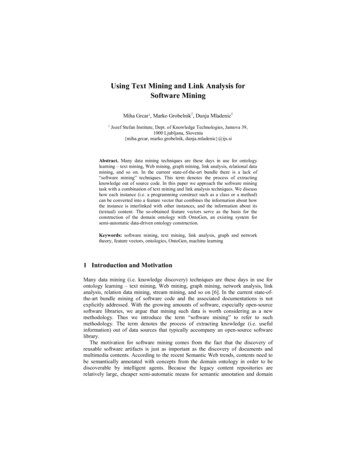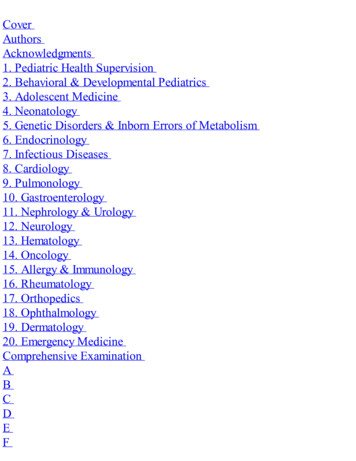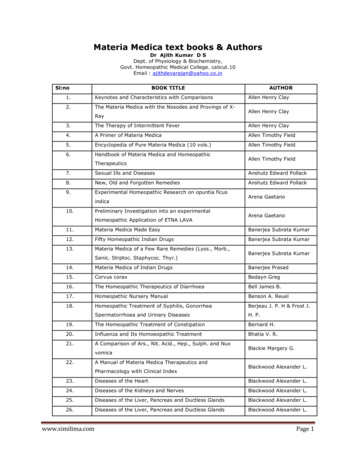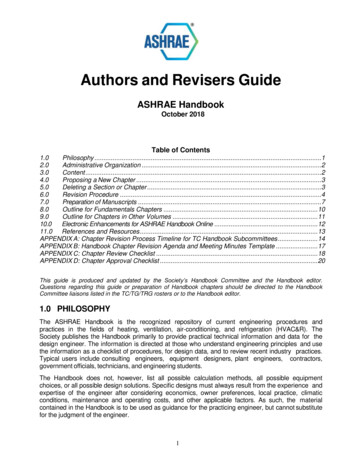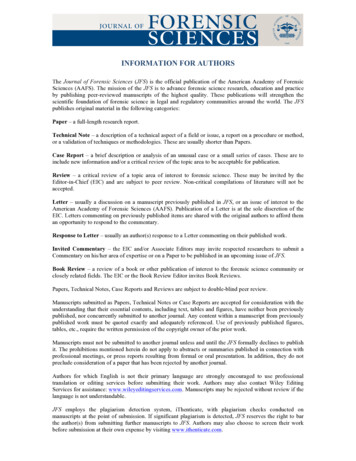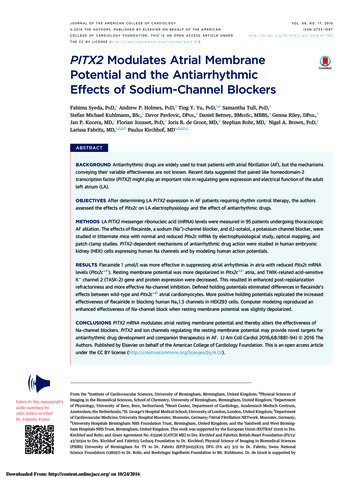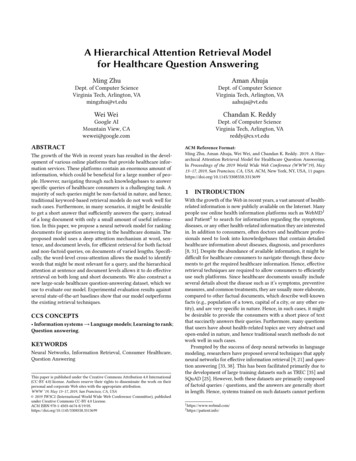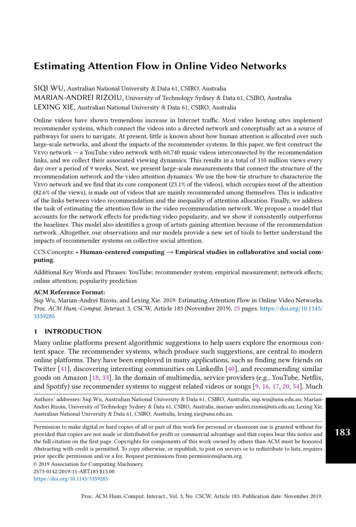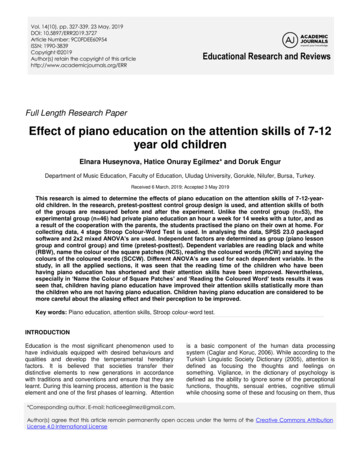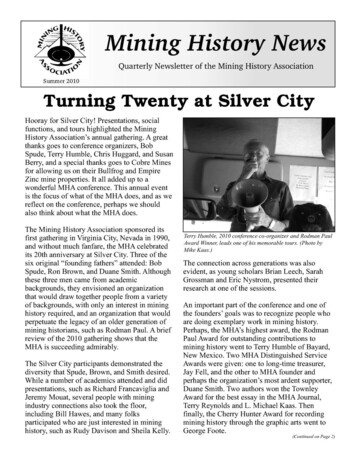
Transcription
Mining History News2Summer 2010"Turning Twenty." (Continued from Page 1)After twenty years, the Mining HistoryAssociation is robust. It is fulfilling the goals ofthe founders, and only a few of those goals werementioned above. But no organization can besuccessful without the active involvement of itsmembers. While a number of people alreadyvolunteer on committees and on the council,there are always openings. Please considergetting involved. The jobs are not too difficult orvery time consuming. Also, while a group maybe successful today, it always needs to reevaluatewhat it does, and consider new ideas and newactivities. Currently the MHA is centered aroundthe annual meeting, with the annual journal andquarterly newsletter playing important parts. Isthere something else that this organization shouldand could be doing? There must be otheractivities or ventures that we could undertake toexpand our understanding of mining history, andto explain our interest to the uninformed.Attention MHA Authors!I have been a member of the MHA since itsinception, and it is an honor to serve as president.I thank you for the opportunity, and pleasecontact me with your ideas or if you wish tovolunteer.Have you written a book on some aspect ofmining history that you think your fellowmembers might find interesting? Starting withthe next issue, the MHA Newsletter will runan annual column in September withannouncements of books on mining historywritten by our members in the past year ortwo. This will supplement, not replace, ourtraditional list of publications and book reviewsin the annual Mining History Journal, and willbe an additional way to bring your work to theattention of our membership.How to participate:Send the complete bibliographic informationplus a 100-120 word summary of the book (likeyou would use for a dust jacket) to EricNystrom, Newsletter Editor, ateric.nystrom@rit.edu. Works of popularhistory, academic studies, poetry, fiction, and artare all welcome, as long as they concern thebroad themes of mining history of interest toour society. The Newsletter Editor reserves theright to edit all content. Submissions will beaccepted throughout the year and printed in theSeptember newsletter. Authors must bemembers of the MHA.Submissions for the upcoming Septembernewsletter will be accepted through the end ofAugust, so send us your book details right away!David A. WolffSpearfish, SDDavid.Wolff@bhsu.eduMining History Association Dues ReminderPlease check the mailing label on the back of this newsletter. Your dues are up-to-datethrough the end of the year on the label. If 2009 is on the label, you have not paid your duesfor this year -- please do so as quickly as possible. Please send your dues, payable to theMining History Association, to Diane Dudley at the address below. Thank you!General Membership:International:Sustaining Membership:Patron Membership:Corporate Member: 25.00 35.00 50.00 100.00 500.00Diane Dudley, Membership ChairMining History AssociationP.O. Box 552Sedalia, CO 80135
Mining History News4Summer 2010"16th c. Mining, Smelthing, and Medicine."(Continued from Page 3)of the Fieger company was 200,000 kilograms of silverand 13,700 tons of copper from 1470 to 1529.weak compounds of mercury could be useful in treatingsyphilis, which was rapidly spreading in Europe.Paracelsus stayed in Schwaz for some time during 15151516 in order to study the smelting, alchemy and assayingmethods used by Sigmund. During this stay Paracelsuslived in Sigmund’s house -- now known as theOrglerhaus.Paracelsus revisited Schwaz and other mining towns of thelower Inn Valley sometime in the period of 1533-1534. Hepresumably renewed his friendship with Sigmund Fiegerand wrote that Fieger was "the most noble and steadfast"friend. Shortly after 1534, Paracelsus went to the miningand smelting town of Sterzing in the South Tyrol (nowVipiteno, Alto Adige, Italy) where he worked on a memoiron the plague for the town council as a plague-doctor.The ores of the Alte Zeche and Falkenstein mines atSchwaz are known as fahlerze in German. Separation ofsilver from the ores was complex and expensive becausethey contained copper, silver, lead, antimony, arsenic, andmercury. The fahlerze contained 35-38% copper and 0.40.6% silver. The separation of silver from copper bysmelting was named the seiger or saiger prozess inGerman (liquidation process in English), and wasdiscovered in the early to mid-1400s probably in theErzegebirge (Ore Mountains) of Saxony. The process firstrequired roasting the ore in an open furnace followed bysmelting after the addition of considerable amounts of leadore. The mixture of ores required as many as seven oreight smelts in succession. The smelts consumed largeamounts of charcoal and required delicate control byobservation of the furnace temperatures. The first tappedliquid from each smelt was lead and silver-rich and wascarefully assayed for silver and lead. The amount of leadore added to the smelts had to be changed to obtain thehighest recovery of silver at the lowest cost, for eachmining district and sometimes for each ore body in asingle district. Cupellation was used after the smelting toseparate the silver from the lead. The silver was sent to theEmperor’s mints at the nearby towns of Hall andRattenberg in the Inn Valley. Paracelsus was interested inthe method of separating metals and semi-metals in thesaiger process and possibly also in the mercury content of0.4-8% in the Schwaz fahlerze because he believed thatNewsletterContributions WelcomeDo you have a piece of research that isinteresting, but much too short for theMining History Journal? News about anupcoming conference or event related tomining history? A tip about a "hidden gem"of an archive? Consider sending it to theMining History News! We are alwayslooking for information of interest to ourfellow members.Contact Newsletter Editor Eric Nystrom ateric.nystrom@rit.edu for further details.Paracelsus wrote voluminously but little was publishedduring his lifetime due to the opposition of theconservative medical, religious, and university authorities.His manuscripts influenced only a small number ofyounger philosophers, termed "Paracelsians," during hislifetime. The number of followers greatly increased soonafter his death in 1541, which caused book publishers tostart publishing his writings. Paracelsus’ book On theMine-Sickness and Other Mining Diseases was written in1537 and first published in 1567. This was the firstpublication on the subject of the lung diseases of miningpeople due to the inhalation of poisonous fumes,especially the arsenic-bearing smelter smoke. Anotherbook on mineralogy by Paracelsus, titled De Mineralibus,was published in 1570 and contains the first description ofzinc as a native metal.Paracelsus’ fame as a contributor to the advance ofmedicine and science has survived to the present day. Thesurviving evidence of the three Fieger brothers is officialmining records and a monument in the Franciscan churchof Schwaz. The Fieger family name disappears frommining history with the death of the "noble" friend andindustrious worker Sigmund Fieger in 1543.Hall of Fame WebsiteThe Mining Foundation of the Southwest hasrevamped its website, and of particular interest toMHA members, lists the American Mining Hall ofFame.The website is: http://www.miningfoundationsw.org--Bill Hawes
Mining History NewsSummer 2010Call for Research Helpon Candidates for Hall5Mining Museum MakesMagazine Top TenBill HawesThe Mining Foundation of the Southwest has a long list ofpotential candidates we feel are worthy of recognition inthe American Mining Hall of Fame, but need researchdone on them. This would be a perfect opportunity forMining History Association members and friends to helpget these important pioneers in mining history therecognition they deserve. Submissions should be on theorder of 300-400 words long, with a photo of thecandidate suitable for reproduction on a recognitionplaque. One other thing needed is the year of thecandidate’s birth and death. Submissions can be made toBill Hawes, Box 501, Humboldt, AZ 86329 or tohardrockhawes@msn.com. If you wish to makesubmissions to the Hall of Fame in Leadville, don’t letyour submission to the American Mining Hall of Famedeter you. Here are some of our most intriguingcandidates:Jack Findley and Burt Royal: Anyone who has workedunderground and had the “pleasure” of hand mucking willimmediately recognize the great debt owed these twogentlemen, who patented the compressed air poweredovershot mucking machine. Some information is availablefrom the ASME, but for the Hall of Fame nominationyears of birth and death, a photograph, and any otherpertinent or interesting information is needed for each.William Otis: Inventor of the steam shovel, patented Feb.24, 1839. Otis was 25 at the time, and died later in 1839. Alimited amount of information appears in the Feb. 2009issue of Smithsonian magazine, but more is needed.A.B. Parsons: Longtime Secretary of the AIME, his twobooks on porphyry copper (The Porphyry Coppers, AIME,1933 and The Porphyry Coppers In 1956, AIME 1957) areperhaps the best source of history on the major coppermines of the 20th century.Lewisohn Brothers: The Lewisohns were importanttraders and financed several major mining projects -- theOld Dominion in Globe, Tennessee Copper, and MiamiCopper, to list a few. They employed J. Parke Channing astheir consulting mining engineer.Roscoe Channing: Brother of J. Parke Channing, collegefootball star, and one of Teddy Roosevelt’s "RoughRiders." Channing was Superintendent of the Highlandmine in Bingham Canyon, and later president (andfounder?) of Hudson Bay Mining and Smelting.The Cripple Creek District Museum, located inthe famous historic mining area of CrippleCreek, Colorado, was honored by True Westmagazine as one of the Top 10 Western Museumsof 2010.The museum rated #9 on the list, published in theMay 2010 issue, right after Boot Hill Museum inDodge City, Kansas. In Colorado, the BuffaloBill Museum and Grave in Golden was rated #3,and New Mexico History Museum in Santa Fetook top honors. "We are so incredibly pleased tohave been chosen for the list," said Director JanCollins. "This is a pretty big deal for our littlemuseum."True West writer Johnny D. Boggs cited theMuseum’s acquisition of two historic cabins as apart of his selection process. The cabins wererelocated to the Museum grounds last fall. Bothhave been furnished to reflect when they wereoccupied by a typical boomtown miner andretired prostitute French Blanche LeCoq,respectively. "Cripple Creek is a legendary OldWest mining town," True West Executive EditorBob Boze Bell said in a recent press release fromthe magazine. "The Cripple Creek DistrictMuseum does an outstanding job of telling itsstory and preserving its history."The Museum is open for the summer from 10a.m. to 5 p.m. seven days a week. For moreinformation on group rates or special tours, call719-689-2634 or email CCDMuseum@aol.comFuture MHA MeetingsDillon, MontanaJune 1-5, 2011Prescott, ArizonaJune 7-10, 2012Galena, IllinoisJune 2013
6Mining History NewsSummer 2010Call for Papers: 2011 Mining HistoryAssociation Meeting at Dillon, MTThe Mining History Association will meet on the campus of the University ofMontana-West in Dillon, June 2-5, 2011, near the historic gold rush towns and districtsof Bannack, Virginia City and Alder Gulch. The Program Committee invites proposalsfor papers, presentations and panels on any aspect of mining history in any era or locationaround the world. Related fields may include science and technology, law andgovernance, labor and social history, industrial archaeology, business history,preservation, reclamation, and environmental history. In celebration of the IdahoMontana gold rush, 1860-1865, proposals on any mining-related aspect of that eraare especially encouraged.Each proposal should be submitted by e-mail, and contain an abstract of no more than500 words, along with a brief c.v. that includes the address, phone number, and email foreach participant. If submitting an entire session, include an abstract that outlines thepurpose of the session and lists names, addresses, phone numbers and emails of allparticipants. The Program Committee assumes all listed individuals in a session proposalagree to participate. Deadline for submissions is December 1, 2010.Proposals and inquiries should be sent by email directly to each of the followingmembers of the Program Committee:Ronald H. Limbaugh: limbaugh@mcn.orgWilliam W. Culver: william.culver@plattsburgh.eduCorky Reinhart: corkyreinhart@gmail.comMHA Nominating Committee Seeking CandidatesThe MHA Nominating Committee is responsible for setting up MHA elections. Weneed your help! Are you, or someone you know, willing to serve the MHA as amember of the council or one of the standing committees? Do you want to proposethe nomination of a fellow member for office? Many MHA positions require onlymodest amounts of time plus attendance at our annual meeting. Please email theNominating Committee (care of Eric Nystrom, eric.nystrom@rit.edu), or write tous: MHA Nominating Committee, P.O. Box 552, Sedalia, CO 80135. Please haveyour suggestions for the upcoming year to the committee by October 15.Nominating Committee MembersNoel Kirshenbaum (2008-2011)Bill Wahl (2009-2012)Eric Nystrom (2010-2013)
Mining History NewsSummer 2010Nominate Books for 2009-10 Spence AwardThe Clark C. Spence Award Committee of the Mining History Association is accepting nominations for the bestbook published on Mining History during 2009-2010. The committee considers books that meet thedocumentation and narrative standards set by the works of Clark Christian Spence, professor emeritus, Universityof Illinois, Urbana-Champaign.To be considered, the book must focus on the history of a specific mining region, or a mining-related theme ortopic, especially within the American West, or an individual or individuals prominent in the history of Americanmining. There are no temporal limits on subjects. The book must be published either in the year 2009 or 2010. A 500 cash prize will be presented to the winning author or authors at the 2011 Mining History AssociationAnnual Meeting.Authors or publishers should send three copies of the nominated work to the Committee chair:David WolffAttn. MHA Spence AwardBlack Hills State University1200 University St, Unit 9059Spearfish, SD 57799Fun Times and Old Friends at Silver City MeetingTop Left: MHA President Karen Vendl is interviewed by a reporter from the Silver City News (Photo by Bob Spude). Top Right:Virgil Leuth prepares the group for his Geology Tour (Photo by Bob Spude). Bottom Center: Roger Burt examines the EmpireZinc headframe (Photo by Eric Nystrom).7
Mining History AssociationP.O. Box 552Sedalia, CO 80135First Class MailUpcoming Events50th Western History AssociationConferenceOctober 13-16, 2010Incline Village (Lake Tahoe), NV22nd Mining History Association ConferenceJune 1-5, 2011Dillon, MThttp://www.mininghistoryassociation.org9th International Mining History CongressAugust 15-18, 2011Johannesburg area, South Africa17th Australian Mining History AssociationConferenceSept. 13-19, 2011Hahndorf, South Australiahttp://www.mininghistory.asn.au23rd Mining History Association ConferenceJune 7-10, 2012Prescott, AZThe Mining History News is published quarterlyby the Mining History Association. It is sent toMHA members who also receive the annualMining History Journal. MHA is an organizationof individuals interested in the history of miningand metallurgy. Submissions for the newsletterare encouraged and should be sent to EricNystrom at the MHA address or by email:eric.nystrom@rit.edu.Deadlines:March issue: February 15June issue: May 15September issue: August 15December issue: November 15Change of Address: Please send all addresschanges to Diane Dudley, Membership Chair,at:Mining History AssociationP.O. Box 552Sedalia, CO 80135www.mininghistoryassociation.org
Future MHA Meetings Dillon, Montana June 1-5, 2011 Prescott, Arizona June 7-10, 2012 Gal
